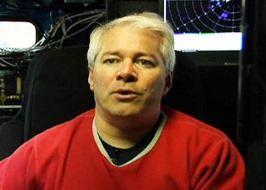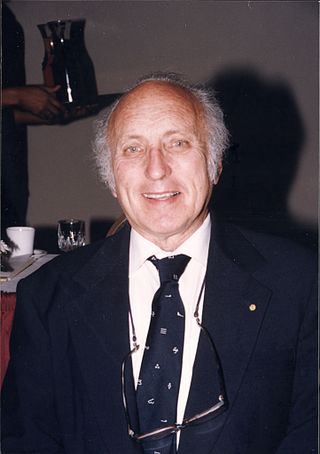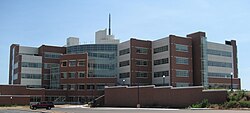
The National Hurricane Center (NHC) is the division of the United States' NOAA/National Weather Service responsible for tracking and predicting tropical weather systems between the Prime Meridian and the 140th meridian west poleward to the 30th parallel north in the northeast Pacific Ocean and the 31st parallel north in the northern Atlantic Ocean. The agency, which is co-located with the Miami branch of the National Weather Service, is situated on the campus of Florida International University in University Park, Miami, Florida.

The National Weather Service (NWS) is an agency of the United States federal government that is tasked with providing weather forecasts, warnings of hazardous weather, and other weather-related products to organizations and the public for the purposes of protection, safety, and general information. It is a part of the National Oceanic and Atmospheric Administration (NOAA) branch of the Department of Commerce, and is headquartered in Silver Spring, Maryland, within the Washington metropolitan area. The agency was known as the United States Weather Bureau from 1890 until it adopted its current name in 1970.

The Storm Prediction Center (SPC) is a US government agency that is part of the National Centers for Environmental Prediction (NCEP), operating under the control of the National Weather Service (NWS), which in turn is part of the National Oceanic and Atmospheric Administration (NOAA) of the United States Department of Commerce (DoC).

The Weather Prediction Center (WPC), located in College Park, Maryland, is one of nine service centers under the umbrella of the National Centers for Environmental Prediction (NCEP), a part of the National Weather Service (NWS), which in turn is part of the National Oceanic and Atmospheric Administration (NOAA) of the U.S. Government. Until March 5, 2013 the Weather Prediction Center was known as the Hydrometeorological Prediction Center (HPC). The Weather Prediction Center serves as a center for quantitative precipitation forecasting, medium range forecasting, and the interpretation of numerical weather prediction computer models.
This is a list of meteorology topics. The terms relate to meteorology, the interdisciplinary scientific study of the atmosphere that focuses on weather processes and forecasting.
The National Severe Storms Laboratory (NSSL) is a National Oceanic and Atmospheric Administration (NOAA) weather research laboratory under the Office of Oceanic and Atmospheric Research. It is one of seven NOAA Research Laboratories (RLs).
The Cooperative Institute for Severe and High-Impact Weather Research and Operations (CIWRO) is one of 16 NOAA Cooperative Institutes (CIs), hosted at the University of Oklahoma. Before Oct. 1, 2021, it was known as the Cooperative Institute for Mesoscale Meteorological Studies (CIMMS). The CIMMS/CIWRO, a research organization created in 1978 by a cooperative agreement between the University of Oklahoma (OU) and the National Oceanic and Atmospheric Administration (NOAA), promotes collaborative research between NOAA and OU scientists on problems of mutual interest to improve basic understanding of mesoscale meteorological phenomena, weather radar, and regional climate to help produce better forecasts and warnings that save lives and property. CIMMS/CIWRO research contributes to the NOAA mission through improvement of the observation, analysis, understanding, and prediction of weather elements and systems and climate anomalies ranging in size from cloud nuclei to multi-state areas.
The College of Atmospheric and Geographic Sciences at the University of Oklahoma consists of the School of Meteorology and Department of Geography & Environmental Sustainability (DGES). The college officially started on January 1, 2006, when it and the College of Earth and Energy were spun-off from the old College of Geosciences, which no longer exists.
The Center for Analysis and Prediction of Storms (CAPS) was established at the University of Oklahoma in 1989 as one of the first eleven National Science Foundation Science and Technology Centers. Located at the National Weather Center in Norman, Oklahoma, its mission is the development of techniques for the computer-based prediction of high-impact local weather, such as individual spring and winter storms, with the NEXRAD (WSR-88D) Doppler weather radar serving as a key data source.

In meteorology and climatology, a mesonet, portmanteau of mesoscale network, is a network of automated weather and, often also including environmental monitoring stations, designed to observe mesoscale meteorological phenomena and/or microclimates.

Joshua Michael Aaron Ryder Wurman is an American atmospheric scientist and inventor noted for tornado, tropical cyclone, and weather radar research.

The following outline is provided as an overview of and topical guide to the field of Meteorology.
On March 21–22, 1952, a severe tornado outbreak generated eight violent tornadoes across the Southern United States, causing 209 fatalities—50 of which occurred in a single tornado in Arkansas. In addition, this tornado outbreak is the deadliest on record to ever affect the state of Tennessee, with 66 of the fatalities associated with this outbreak occurring in the state; this surpasses the 60 fatalities from a tornado outbreak in 1909, and in terms of fatalities is well ahead of both the 1974 Super Outbreak and the Super Tuesday tornado outbreak, each of which generated 45 and 31 fatalities, respectively. The severe weather event also resulted in the fourth-largest number of tornado fatalities within a 24-hour period since 1950. To date this was considered the most destructive tornado outbreak in Arkansas on record.

The Verification of the Origins of Rotation in Tornadoes Experiment are field experiments that study tornadoes. VORTEX1 was the first time scientists completely researched the entire evolution of a tornado with an array of instrumentation, enabling a greater understanding of the processes involved with tornadogenesis. A violent tornado near Union City, Oklahoma was documented in its entirety by chasers of the Tornado Intercept Project (TIP) in 1973. Their visual observations led to advancement in understanding of tornado structure and life cycles.

From May 3 to May 11, 2003, a prolonged and destructive series of tornado outbreaks affected much of the Great Plains and Eastern United States. Most of the severe activity was concentrated between May 4 and May 10, which saw more tornadoes than any other week-long span in recorded history; 335 tornadoes occurred during this period, concentrated in the Ozarks and central Mississippi River Valley. Additional tornadoes were produced by the same storm systems from May 3 to May 11, producing 363 tornadoes overall, of which 62 were significant. Six of the tornadoes were rated F4, and of these four occurred on May 4, the most prolific day of the tornado outbreak sequence; these were the outbreak's strongest tornadoes. Damage caused by the severe weather and associated flooding amounted to US$4.1 billion, making it the costliest U.S. tornado outbreak of the 2000s. A total of 50 deaths and 713 injuries were caused by the severe weather, with a majority caused by tornadoes; the deadliest tornado was an F4 that struck Madison and Henderson counties in Tennessee, killing 11.
From April 27–29, 1912, a major tornado outbreak generated at least six violent tornadoes in Oklahoma, with near-constant activity until early the next day. At least 15 cities were affected, 40 people died, and 120 others were injured. Tornado researcher Thomas P. Grazulis considered this outbreak to be among the worst on record in the state of Oklahoma, as measured by fatalities and violent tornadoes. At least five strong tornadoes affected Washita County, Oklahoma, during this outbreak.
The following is a glossary of tornado terms. It includes scientific as well as selected informal terminology.

Roger Edwards is an American meteorologist and expert on severe convective storms (thunderstorms). He is the co-founder and editor-in-chief of the Electronic Journal of Severe Storms Meteorology (EJSSM).

Edwin Kessler III was an American atmospheric scientist who oversaw the development of Doppler weather radar and was the first director of the National Severe Storms Laboratory (NSSL).












